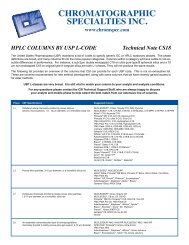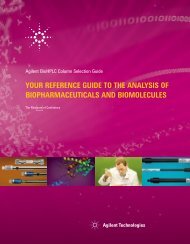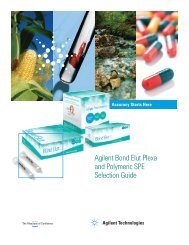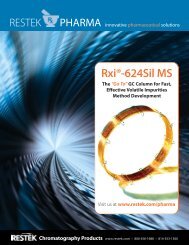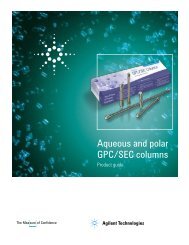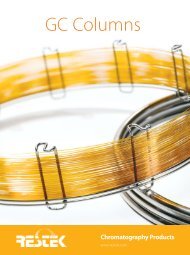Optimizing the Analysis of Volatile Organic Compounds
Optimizing the Analysis of Volatile Organic Compounds
Optimizing the Analysis of Volatile Organic Compounds
You also want an ePaper? Increase the reach of your titles
YUMPU automatically turns print PDFs into web optimized ePapers that Google loves.
20<br />
Universal Press-Tight ®<br />
Connectors<br />
Description cat.#<br />
Universal Press-Tight ® Connectors, 5-pk. 20400<br />
Universal Press-Tight ® Connectors, 25-pk. 20401<br />
Universal Press-Tight ® Connectors, 100-pk.<br />
Universal Angled “Y” Press-Tight<br />
20402<br />
®<br />
Connector, ea.<br />
Universal Angled “Y” Press-Tight<br />
20403<br />
®<br />
Connectors, 3-pk. 20404<br />
For additional connectors, see page 64.<br />
www.restekcorp.com<br />
Direct Connection<br />
A union between <strong>the</strong> purge and trap transfer line and <strong>the</strong> capillary column bypasses <strong>the</strong><br />
injection port, eliminating <strong>the</strong> problems associated with <strong>the</strong> injection port: loss <strong>of</strong> sample<br />
through <strong>the</strong> septum purge, adsorption <strong>of</strong> active compounds, bleed from Viton ® O-rings or<br />
septum, and — most important — dead volume. Two direct connections are described<br />
below. The disadvantage <strong>of</strong> a direct connection is it eliminates <strong>the</strong> ability to make manual<br />
injections when attempting to isolate a chromatographic problem. Therefore, this connection<br />
technique works best for experienced analysts and for instruments that undergo regular<br />
maintenance.<br />
Metal Transfer Line: This is <strong>the</strong> easier <strong>of</strong> <strong>the</strong> two direct connection methods. Using <strong>the</strong><br />
transfer line provided by <strong>the</strong> instrument manufacturer and an MXT ® low dead volume connector<br />
(cat.# 20394, see our catalog), connect <strong>the</strong> trap to <strong>the</strong> capillary column. This configuration<br />
significantly improves peak shape, compared to injection port connections, especially<br />
with an electrolytic conductivity detector (ELCD).<br />
Fused Silica Transfer Line: A fused silica transfer line fur<strong>the</strong>r reduces dead volume, relative<br />
to <strong>the</strong> original equipment line. We recommend using Siltek ® fused silica tubing for VOC<br />
or o<strong>the</strong>r sensitive analyses because it is not affected by moisture and is inert to active compounds.<br />
To configure <strong>the</strong> line, disconnect <strong>the</strong> metal transfer line from <strong>the</strong> Valco ® six-port<br />
valve, <strong>the</strong>n remove <strong>the</strong> metal ferrule and 1/16" nut by cutting <strong>the</strong> end <strong>of</strong> <strong>the</strong> tubing. While<br />
wearing insulated gloves, heat <strong>the</strong> line to 200°C to melt <strong>the</strong> glue that holds <strong>the</strong> line in place,<br />
<strong>the</strong>n use pliers to pull <strong>the</strong> line out <strong>of</strong> <strong>the</strong> heater jacket. Cool <strong>the</strong> line, install a piece <strong>of</strong> metal<br />
tubing (cat. #21503, see our catalog) inside <strong>the</strong> line, <strong>the</strong>n install <strong>the</strong> Siltek ® -treated fused silica<br />
transfer line within <strong>the</strong> metal tubing (cat. #10027, page 63). The metal tubing will prevent<br />
<strong>the</strong> transfer line from being scratched or broken. Base <strong>the</strong> ID <strong>of</strong> <strong>the</strong> metal tubing on <strong>the</strong> OD<br />
<strong>of</strong> <strong>the</strong> transfer line: 0.02" ID for a 0.25 or 0.32mm ID fused silica line, 0.30" ID for a 0.45<br />
or 0.53mm ID line. In turn, base <strong>the</strong> ID <strong>of</strong> <strong>the</strong> transfer line on <strong>the</strong> ID <strong>of</strong> <strong>the</strong> analytical column;<br />
we recommend using a transfer line with an ID equal to or slightly smaller than that <strong>of</strong><br />
<strong>the</strong> column. A transfer line with an ID slightly smaller than that <strong>of</strong> <strong>the</strong> column will increase<br />
backpressure, enhancing <strong>the</strong> resolution <strong>of</strong> early-eluting compounds. Use a Press-Tight ® connector<br />
(cat. #20400 or 20403, page 20) to connect <strong>the</strong> fused silica transfer line to <strong>the</strong> analytical<br />
column (Figure 17). Use <strong>the</strong> correct ferrule for connecting <strong>the</strong> column to <strong>the</strong> 6-port valve<br />
(Figure 18); we recommend a one-piece fused silica adaptor (cat. #20137, page 64).<br />
Figure 17.<br />
A dual-column configuration splits <strong>the</strong> sample equally between separate detector systems.<br />
Angled “Y”<br />
Press-Tight ®<br />
Connector<br />
Figure 18.<br />
Connect <strong>the</strong> fused silica line directly to <strong>the</strong> 6-port valve. Notice a small (5mm)<br />
septum helps determine how far <strong>the</strong> column is inserted into <strong>the</strong> valve, preventing breakage<br />
at <strong>the</strong> column end that could allow shards <strong>of</strong> fused silica to enter <strong>the</strong> valve.<br />
MXT ® Metal Tubing<br />
(used to protect fused<br />
silica column)<br />
Fused Silica<br />
Septum





